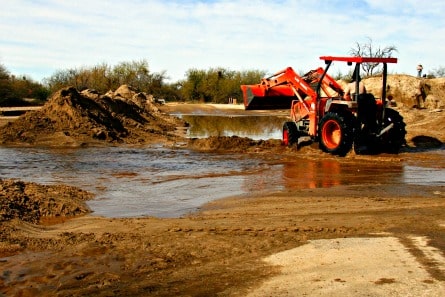You’re on what you hope will be a leisurely RV camping trip. It’s a warm summer afternoon. Suddenly, a few raindrops splat your arms, and before you know it, the sky opens up. Then you hear thunder in the distance. What should you do to ensure your family’s safety?

Following heavy rains in the mountains a wash separating the campground from the entrance road at Catalina State Park near Tucson flooded stranding campers for several days. © Rex Vogel, all rights reserved
Stormy weather can happen at any time, anywhere.
While your best choice depends on the severity of the storm and your location, being prepared to act quickly could be a matter of survival. Knowing what to do before, during, and following severe weather is a critical part of being prepared and may make all the difference when seconds count.
Be Informed
Know the risk in your area for hurricanes, tornados, thunderstorms, damaging winds, dust storms, blizzards, ice storms, and other severe weather phenomena.
NOAA Weather Radio continuously broadcasts National Weather Service warnings, watches, alerts, forecasts, and other hazard information 24 hours a day. The National Weather Service recommends purchasing a radio that has both a battery backup and a tone-alert feature which automatically alerts you when a watch or warning is issued.
Make a Weather Disaster Plan
Create a weather disaster plan, put an emergency kit together, and keep important papers and valuables in a safe place. Most emergency preparedness plans have several steps in common, such as having a well-stocked first aid kit. Begin your plan with one or more ways of staying on top of weather forecasts.
Some communities use sirens as a warning system. Check with your RV campground regarding local siren signals, their storm warning system, and location of nearest tornado shelter.
Build an Emergency Kit

Following a path cleared by state park staff, RVs were able to leave Catalina State Park. © Rex Vogel, all rights reserved
Assemble your emergency survival kit well in advance of an emergency. These basic supplies should include water, non-perishable food, can opener, first aid kit, medications and medical treatment items, flashlights, cell phone with charger, NOAA Weather Radio, emergency cash, pet supplies, important personal documents and medical information, road maps, emergency blankets, flameless LED candles, emergency tools, emergency contact information including family, friends, and doctors, and a full tank of fuel. Keep them readily accessible in an easy-to-carry kit.
Additional Safety Tips
ALWAYS know the county in which you are located, so that you can get accurate weather information (National Weather Service severe weather warnings are issued based on counties).
DO NOT drive into a flooded area.
30/30 Rule – if the time between lightning strikes and thunder is less than 30 seconds, you need to take shelter.
NEVER try to outrun a tornado in any vehicle; instead, take shelter immediately.
Remember, Safety doesn’t happen by accident.

Don Baxter Pelley
If you learn that a possible tornado or dangerous storm is coming your way. Get to safe shelter. Many parks have a safe club house. Knock on your neighbors door and advise where you're going and why. An emergency radio is really important. cheers.
Newby Fun Resorts
In Florida it's a good idea to take ponchos with you whenever you're outside for long periods of time in the summer. Always check the weather forecast because this state is known for random showers! Thanks for the post.